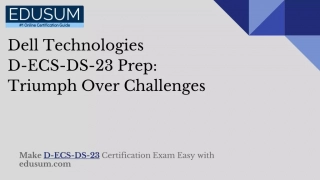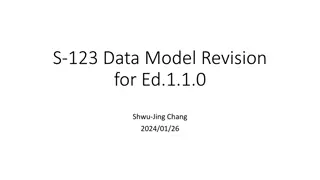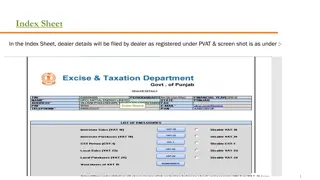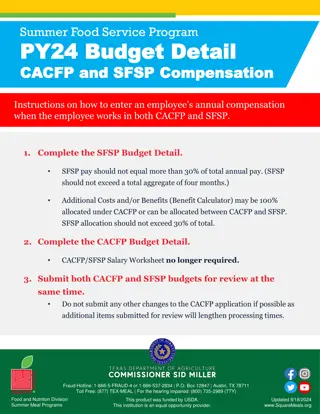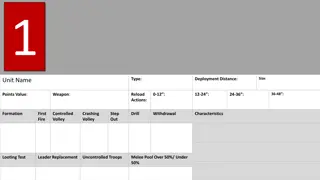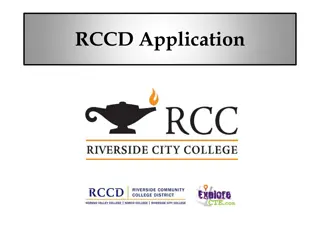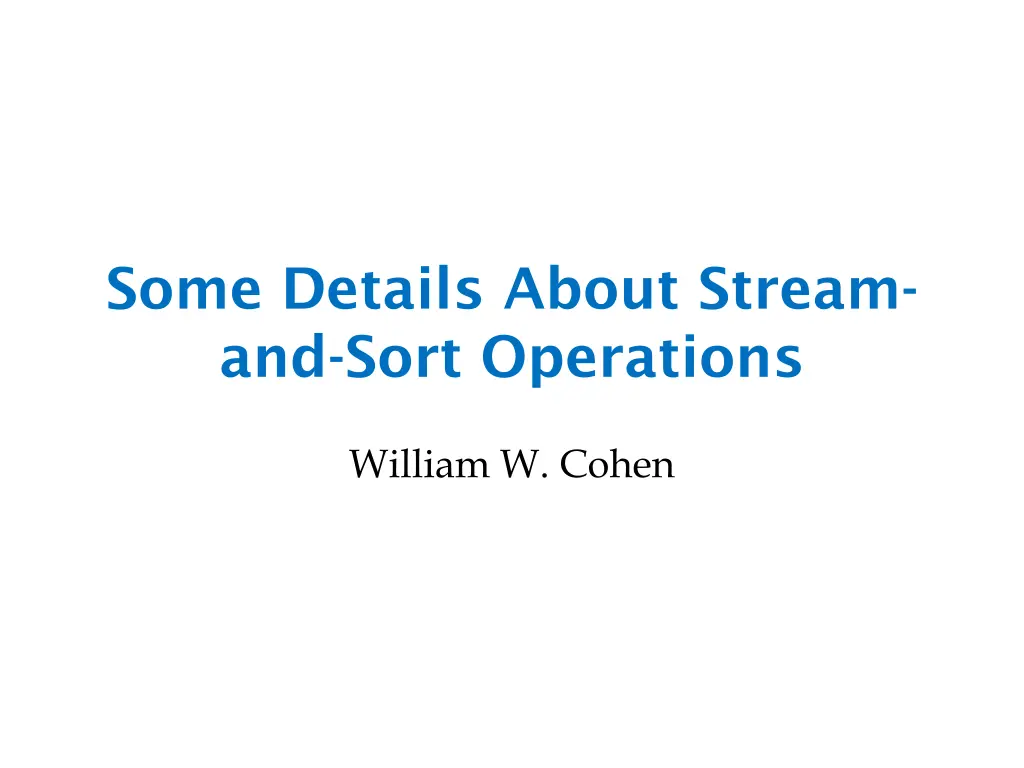
Understanding Stream and Sort Operations Across Different Sorting Techniques
Explore the evolution of stream and sort operations through various sorting methods like merge sorts, old-school merge sort, 21st-century sorting, and Unix sort. Learn about the process, optimizations, and parallelization possibilities in sorting algorithms like bottom-up merge sort, Unix pipes, and stream-and-sort pipelines.
Download Presentation

Please find below an Image/Link to download the presentation.
The content on the website is provided AS IS for your information and personal use only. It may not be sold, licensed, or shared on other websites without obtaining consent from the author. If you encounter any issues during the download, it is possible that the publisher has removed the file from their server.
You are allowed to download the files provided on this website for personal or commercial use, subject to the condition that they are used lawfully. All files are the property of their respective owners.
The content on the website is provided AS IS for your information and personal use only. It may not be sold, licensed, or shared on other websites without obtaining consent from the author.
E N D
Presentation Transcript
Some Details About Stream- and-Sort Operations William W. Cohen
Bottom-Up Merge Sort use: input array A[n]; buffer array B[n] assert: A[ ] contains sorted runs of length r=1 for run-length r=1,2,4,8, merge adjacent length-r runs in A[ ], copying the result into the buffer B[ ] assert: B[ ] contains sorted runs of length 2*r swap roles of A and B
Wikipedia on Old-School Merge Sort Use four tape drives A,B,C,D 1. merge runs from A,B and write them alternately into C,D 2. merge runs from C,D and write them alternately into A,B 3. And so on . Requires only constant memory.
Unix Sort Load as much as you can [actually --buffer-size=SIZE] into memory and do an in- memory sort [usually quicksort]. If you have more to do, then spill this sorted buffer out on to disk, and get a another buffer s worth of data. Finally, merge your spill buffers.
How Unix Pipes Work Processes are all started at the same time Data streaming thru the paper is held in a queue: writer [ queue ] reader If the queue is full: the writing process is blocked If the queue is empty: the reading process is blocked (I think) queues are usually smallish: 64k
How stream-and-sort works Pipeline is stream [ queue ] sort Algorithm you get: sort reads --buffer-size lines in, sorts them, spills them to disk sort merges spill files after stream closes stream is blocked when sort falls behind and sort is blocked if it gets ahead
LOOKING AHEAD TO PARALLELIZATION
Stream and Sort Counting Distributed Counting Standardized message routing logic example 1 example 2 example 3 . C[x1] += D1 C[x1] += D2 . C[x] +=D Logic to combine counter updates Sort Counting logic Machines A1, Machines C1,.., Machines B1, , Easy to parallelize! Trivial to parallelize!
Stream and Sort Counting Distributed Counting example 1 example 2 example 3 . C[x1] += D1 C[x1] += D2 . Spill 1 Merge Spill Files Spill 2 Logic to combine counter updates Spill 3 Counting logic Sort C[x] +=D Machines A1, Machines C1,..,
Stream and Sort Counting Distributed Counting example 1 example 2 example 3 . C[x1] += D1 C[x1] += D2 . Spill 1 Merge Spill Files Spill 2 Logic to combine counter updates Spill 3 Counting logic Sort C[x] +=D Counter Machine Combiner Machine
Stream and Sort Counting Distributed Counting Counter Machine 1 Combiner Machine 1 example 1 example 2 example 3 . C[x1] += D1 C[x1] += D2 . Spill 1 Merge Spill Files Spill 2 Partition/Sort Spill 3 Logic to combine counter updates Counting logic Spill n example 1 example 2 example 3 . C[x1] += D1 C[x1] += D2 . Spill 1 Merge Spill Files Spill 2 Partition/Sort Spill 3 combine counter updates Counting logic Combiner Machine 2 Counter Machine 2
Review: Large-vocab Nave Bayes Create a hashtable C For each example id, y, x1, .,xdin train: C( Y=ANY ) ++; C( Y=y ) ++ For j in 1..d: C( Y=y ^ X=xj ) ++
Large-vocabulary Nave Bayes Create a hashtable C For each example id, y, x1, .,xdin train: C( Y=ANY ) ++; C( Y=y ) ++ Print Y=ANY += 1 Print Y=y += 1 For j in 1..d: C( Y=y ^ X=xj ) ++ Print Y=y ^ X=xj+= 1 Sort the event-counter update messages Scan the sorted messages and compute and output the final counter values Think of these as messages to another component to increment the counters java MyTrainertrain | sort | java MyCountAdder > model
Large-vocabulary Nave Bayes Y=business Y=business Y=business ^ X =aaa += Y=business ^ X=zynga += 1 Y=sports ^ X=hat Y=sports ^ X=hockey += Y=sports ^ X=hockey += Y=sports ^ X=hockey += Y=sports ^ X=hoe Y=sports += += 1 1 Create a hashtable C For each example id, y, x1, .,xdin train: C( Y=ANY ) ++; C( Y=y ) ++ Print Y=ANY += 1 Print Y=y += 1 For j in 1..d: C( Y=y ^ X=xj ) ++ Print Y=y ^ X=xj+= 1 Sort the event-counter update messages We re collecting together messages about the same counter Scan and add the sorted messages and output the final counter values 1 += 1 1 1 1 += 1 += 1
Large-vocabulary Nave Bayes Scan-and-add: streaming previousKey = Null sumForPreviousKey = 0 For each (event,delta) in input: If event==previousKey sumForPreviousKey += delta Else OutputPreviousKey() previousKey = event sumForPreviousKey = delta OutputPreviousKey() Y=business Y=business Y=business ^ X =aaa += Y=business ^ X=zynga += 1 Y=sports ^ X=hat Y=sports ^ X=hockey += Y=sports ^ X=hockey += Y=sports ^ X=hockey += Y=sports ^ X=hoe Y=sports += += 1 1 1 += 1 1 1 1 += 1 define OutputPreviousKey(): If PreviousKey!=Null print PreviousKey,sumForPreviousKey += 1 Accumulating the event counts requires constantstorage as long as the input is sorted.
Distributed Counting Stream and Sort Counting example 1 example 2 example 3 . Machine 1 Hash table1 Message-routing logic Machine 2 Hash table2 C[x] +=D Counting logic . . . Machine K Hash table2 Machine 0
Distributed Counting Stream and Sort Counting example 1 example 2 example 3 . C[x1] += D1 C[x1] += D2 . C[x] +=D Logic to combine counter updates Sort BUFFER Counting logic Machine A Machine C Machine B
Review: Large-vocab Nave Bayes Create a hashtable C For each example id, y, x1, .,xdin train: C.inc( Y=ANY ); C.inc( Y=y ) For j in 1..d: C.inc( Y=y ^ X=xj ) class EventCounter { void inc(String event) { // increment the right hashtable slot if (hashtable.size()>BUFFER_SIZE) { for (e,n) in hashtable.entries : print e + \t + n hashtable.clear(); } } }
How much does buffering help? small-events.txt: nb.jar time java -cp nb.jar com.wcohen.SmallStreamNB < RCV1.small_train.txt \ | sort -k1,1 \ | java -cp nb.jar com.wcohen.StreamSumReducer> small-events.txt test-small: small-events.txt nb.jar time java -cp nb.jar com.wcohen.SmallStreamNB \ RCV1.small_test.txt MCAT,CCAT,GCAT,ECAT 2000 < small-events.txt \ | cut -f3 | sort | uniq -c BUFFER_SIZE none 100 1,000 10,000 100,000 1,000,000 limit Time Message Size 1.7M words 1.2M 1.0M 0.7M 0.24M 0.16M 0.05M 47s 42s 30s 16s 13s



